
Publisher:
Bonnie King
CONTACT:
Newsroom@Salem-news.com
Advertising:
Adsales@Salem-news.com

~Truth~
~Justice~
~Peace~
TJP
Mar-08-2014 10:04

 TweetFollow @OregonNews
TweetFollow @OregonNews
Resisters of Sykes-Picot Land Grab Perform Key Fighting Roles in Syria
Dr. Franklin Lamb Salem-News.com"Syria will not kneel to the Zionist-Arab project to destroy the unity and independence of the Syrian Arab Republic” - PFLI fighters
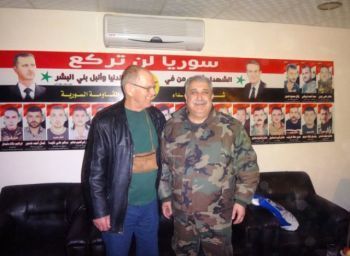 Commander Ali Kayali of the Popular Front for the Liberation of Iskanderun (PFLI) 3/4/14 Latakia |
(NORTH OF LATAKIA, Syria) - Every school kid here in Syria learns at an early age about the various colonial land grabs that have lopped off key parts of their ancient country, and they receive instruction about their national duty to recover this sacred territory. The concept applies equally to still-occupied Palestine, or at least it did before the 2011 uprising got started, albeit since then a degree of resentment has arisen over participation by some Palestinians with rebel groups seeking to topple the Syrian government.
Be that as it may, one such land grab historically remembered, and which is currently galvanizing resistance on behalf of Syria, is that of Iskenderun, north of Latakia, in a disputed Syria-Turkish border area. As Turkish, Saudi, and Qatari-sponsored jihadists continue to enter the country, well worth remembering is it that Iskenderun is rich in natural resources and that for thousands of years it was part of Syria. But that status changed more than half a century ago when France cut it off from Syria and grafted it onto Turkey—and now some pro-government militias are fighting to get it back.
The name derives from Alexander the Great, who around 333 BC encamped in the area and ordered a city be built, although the exact site of the historic city is subject to dispute. At any rate, the strategic importance of Iskenderun comes from its geographical relation to Syrian Gates, the easiest approach to the open ground of Hatay Province and Aleppo, and the dispute over it has been heating up recently, partly as a result of the current crisis.
 Occupied Iskenderun |
It all started on July 5, 1938, when Turkish forces under Colonel Sukril Kanath launched an aggression, with French approval, and ethnically cleansed the local Armenian Christian and Allawi populations. The Turkish invasion was enabled by the French, partners with Britain in Sykes-Picot, who had remained as illegal occupiers of Syria, a holdover from the League of Nations mandate. The French were complicit in a rigged referendum, essentially ceding to Turkey this Syrian territory, which by then was referred to as the Republic of Hatay. It was a land grab. Pure and simple. And it was part of a secret deal to secure Turkey’s help with the fast approaching war with Germany. Paris and Ankara struck a deal: Turkey, while not joining the allies against Germany, declared neutrality and essentially sat out World War II.
Syria, rather than being expansionist, as it is sometimes accused of by Turkey and the Zionist regime, has actually been losing territory, not gaining it. “We lost northern Palestine in 1918, Lebanon in 1920, and the Iskenderun area through French duplicity,” said a retired diplomat here. “Surely Lebanon must also be returned to Syria. It was never a real country and it never will be as far as I am concerned. It is part of Syria!” Indeed, as Robert Fisk points out, after the First World War, most Lebanese wished their land to remain part of Syria (see the results of the King-Crane Commission) rather than live in a separate “nation” under French domination. As we parted, the gentleman shook my hand and declared: “Of course Iskendurun is part of Syria. No honest person can deny this!”
Enter one remarkable Syrian nationalist, Ali Kayali, aka “Abu Zaki”. So how did a polite gentleman from this region of Turkish-occupied Syria end up leading one of the most effective resistance militias in the northern theater in the current Syrian crisis? Basically he did it the same way as untold numbers of Palestinians supporting young Syrian men during the early 1980’s. Ali went to Beirut to resist the 1982 Zionist aggression. There he was baptized by fire, so to speak, carrying the banner of his new group, the Popular Front for the Liberation of Iskenderun (PFLI) under the tutelage of Dr. George Habash and the Popular Front for the Liberation of Palestine (PFLP). Ali fought in a number of south Lebanon fronts, and also inside West Beirut, but then after the PLO withdrawal (on 8/20/82), he returned to Syria, to Tartous, joining the rebellion against PLO Chairman Yasser Arafat. Near Bedwari camp he fought, as part of the Fatah Intifada uprising, this following the PLO split along -pro-Arafat and pro-Hafez Assad cleavages.
Later, Ali undertook study on his own in Tartous (Tripoli, Syria), and at one point escaped from prison in Turkey where he had been jailed for demonstrating against the fascist regime in Ankara. Returning to Syria, he joined Syrian Army battles against the Bilal Shaaban-led Al Tawhid Islamic (Muslim Brotherhood ), following which he and the PFLI moved to the area of Halba in Akkar, Lebanon, and organized a resistance training camp. Eventually, however, he returned to Syria to continue the fight to liberate the Syrian territory of Iskenderun, and while supported by Syrian citizens, the Kayali-led group was not formally part of the Syrian security/resistance apparatus.
Speaking with non-government analysts in Latkia, this observer was repeatedly told that the PFLI has the reputation of understanding the geography and politics of the Syrian coast area where its fighters are currently active, including Aleppo, Banias, between Tartous and the countryside around Latakia, as well as the Idlib, Homs and Damascus areas.
As PFLI fighters and officials put it, "Syria will not kneel to the Zionist-Arab project to destroy the unity and independence of the Syrian Arab Republic.” According to one PFLI spokesperson, the group “supports and stands in the same trench, hand in hand with the state, confronting two foreign projects—the first being to destroy the achievements of the Syrian people and Syria’s social fabric and multi-cultural heritage, and the second being to infiltrate foreign intruders.”
One place the PFLI is currently fighting is the strategic rebel bastion of Yabrud, in the Qalamoun Mountains, north of Damascus, near the Lebanese border. On 3/3/14, during a meeting with this observer and some of his associates, Ali Kyali received a phone call relaying information that Sahel village, about four miles from Yabrud, had come under control of Syrian and pro-Syrian forces, including the PFLI. Remarkably open with battlefield details, Ali explained that pro-Syria forces do not want to occupy Yabrud, but rather the strategy is to control the villages surrounding it in order to trap al Nursa and other rebel militia inside. Asked about the trapped local population and reminded of the fate of the inner city populations of Aleppo, Homs and a dozen other locations, Ali shrugged and turned up his palms.
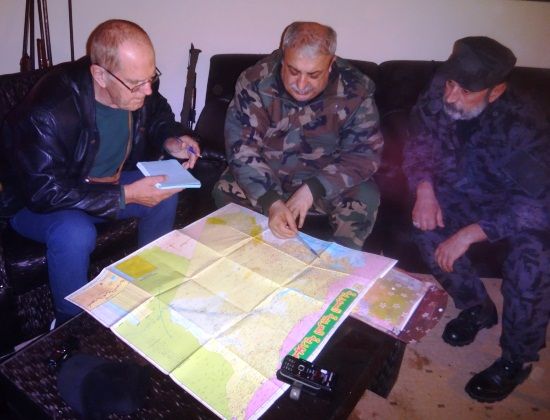 Commander Ali discussing PFLI positions 3/4/14 |
Today (3/7/14) the PFLI is fighting to try to cut off the road linking Yabrud to Arsal in eastern Lebanon, whose majority population supports the Syrian revolt. PFIL fighters were involved last week with the fall of Al-Sahl, a town a little over a mile south of Yabrud, and now are fighting in and around Yaboud, preparing for the anticipated final assault. According to Ali’s personal bodyguards, they are facing Al-Qaida's Syria affiliate, al-Nusra Front. Some of PFLI’s 3000 troops are also fighting this week in Douma, Jobar, Aleppo, the countryside around Lattakia, and Deralcia near Nubek on the main Damascus-Homs highway. They also played a key role earlier in Baniyas, in the battle between Tartous and Latakia. One YouTube clip being given to visitors to the PFLI HQ in Latakia shows the group’s participation, including women, in a recent important battle against the ISIS: https://www.youtube.com/watch?
The PFLI organization receives a variety of random and sporadic support from the local community, according to Mr. Kayali and his staff, but they, like most militia, need money and weapons and regular supplies of food. Also needed are places for the fighters to sleep, as well as more uniforms to accommodate a sharp influx of applicants seeking to join their ranks. Additionally there is the matter of funding death benefit payments for the families of PFLI men and women killed during resistance.
PFLI fighters are not paid salaries, which sets them apart financially from many Gulf-backed and Western-trained militia, who can garner monthly salaries from $500-$1,000. By contrast, pro-government popular committees, numbering approximately 5,000, and National Defense units, whose fighters number around 25,000, receive approximately 20,000 Syrian Pounds, or $126 a month. Footing much of this bill are Syrian businessmen such as Rami Mahlouf, cousin of President Bashar Assad. Regular Syrian army recruits get only 3000 Syrian pounds, or about $20 monthly, but they also receive food and lodging and health and travel benefits. Syrian army reservists are said to receive approximately $10.50 per month.
For Ali Kayali, the PFLI is also a family matter. His wife and daughter and two sons are deeply connected with its resistance goals. His sons are fighters, as are his wife and daughter when called upon, though in-between time they do other resistance projects. Nicked-named “Joan of Arc,” his 22-year-old daughter attends medical school, but reportedly is also a ferocious fighter and adept battlefield tactician, with dramatic results in a number of battles against rebels over the past nearly two years. She is a strong, no-nonsense feminist and told me she loves to shock takfiris, who sometimes appear amazed to see her and her female unit chasing them up the side of some mountain.
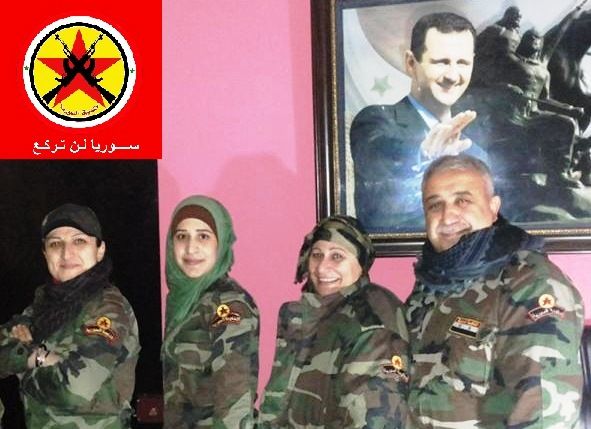 "Joan of arc" with part of her Resistance family |
It is said that an army (or a militia, for that matter) travels on its stomach. This observer was treated to an impromptu roadside lunch with half a dozen PFLI fighters last week. Their favorite cook, Mahmoud, a small guy who always seems to wear the same blue shirt, invited us. Within minutes, Mahmoud gathered some twigs and small chunks of wood, lit a small fire, covered it with a metal grate, grabbed a bag of flour, mixed in water, kneaded it a bit, and shaped and roasted some small, irregular round loaves. On these he sprinkled, from another plastic bag, some handfuls of spices. His fast and hot food was delicious, constituting Mhamra manouche (roasted pita bread with spicy red pepper sauce), Zaatar manouche (oregano, thyme, & sesame seeds), and Jibneh (cheese) manouche.
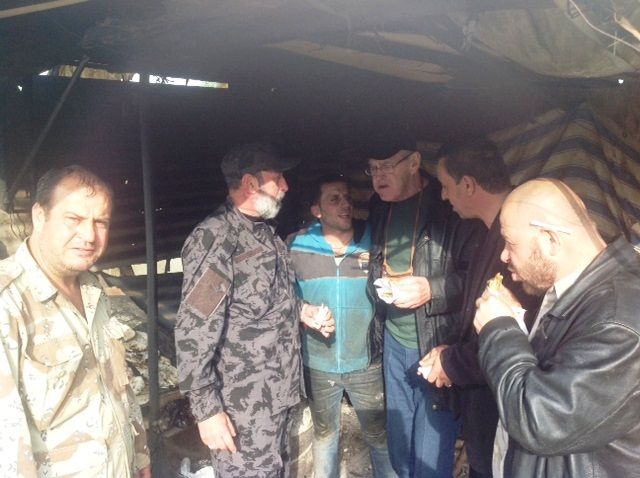 Roadside lunch with Mahmoud and PFLI fighters 3/4/14 |
Captagon Jihad?
Sitting in the lobby of a run-down, less-than-one-star, dockside hotel opposite the Mediterranean, a lodging establishment occasionally used as quarters by various militia, this observer and his companion spoke leisurely one early morning with one of Ali Kyali’s sons and a companion. When not fighting jihadists (in “Have AK-47, Will Travel”-mode), they are among his father’s bodyguards. I have for a while been interested in claims by Western governments that they are supplying “humanitarian non-lethal aid” to rebel groups, including night goggles, telecommunication equipment, and GPS devices. This observer views all such equipment as misnamed and indeed lethal inasmuch as they facilitate one side killing the other via night snipers or through expedition of troop movements. I was a bit surprised to learn what PFLI fighters thought of this kind of equipment being given to their adversaries and labeled ‘humanitarian aid.’
“Not having night goggles, except for some we take off the enemy, is not much of a problem for us because we can sense where al Nusra fighters are, and they tend not to fight at night,” Ali’s son told me.
I asked why the reluctance to fight at night, thinking maybe it had something to do with a religious edict of some sort, but once more I was mistaken.
“No it’s not that, it’s because they are too paranoid and exhausted, from taking captagon and even stronger drugs, to fight at night.”
According the guys I was sitting with, some with more than two years fighting experience with the PFLI, many, if not most, of the Gulf-sponsored jihadists are given bags of pills to enhance their battlefield courage. And it works to a degree. At dawn each day, jihadists take drugs, including large doses of captagon and other widely available drugs. There also are some particularly potent drugs, known locally as “baltcon,” “afoun,” and “zolm,” as well as opium, heroin, cocaine, and hashish. The main drug routes into the Syrian battle zones, I was advised, run from Pakistan, Afghanistan and Lebanon, with lesser amounts coming via Turkey, Iraq and Jordan. Lebanon’s Bekaa valley apparently produces large amounts of captagon pills for shipment to the Gulf, and now to Syria. Jihadists high on drugs apparently feel invincible, and hostile, and do not fear death. Many are indeed ferocious and fearless fighters during the day, as many media sources have reported. But by nightfall, when the drug wears off, the fighters become exhausted and sometimes are found asleep on the very scene of battle they were fighting from.
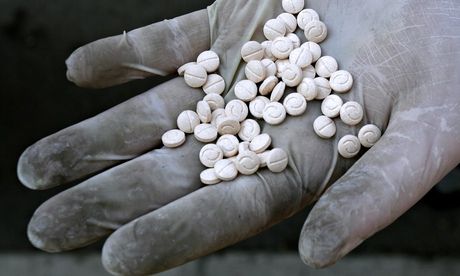 Captagon, a popular 'battlefield courage booster' |
“Many of the ‘Gulfies’ are in fact heavily addicted to strong heroin-like drugs. They crave them, and sometimes they even fight with their fellow militiamen to get their ‘fixes.’ We are told by some we capture that sometimes, when one of their comrades is killed, the fallen fighter’s ‘friends’ will descend on his body, not particularly to pray over it, but to rummage his pockets for his drugs.”
In point of fact, in 2011 alone, Lebanese authorities confiscated three amphetamine production labs, in addition to two Captagon-producing labs, which they claim were responsible for sending hundreds of thousands of the pills to the Gulf. The seizure of trucks with captagon in their chassis in Lebanon, and at Beirut airport, shows a growing demand for these products in the Syrian militia market. The UN recently reported that the Middle and Near East are experiencing the majority of drug busts globally.
Al Nusra Front and ISIS—being some of the more extreme “imported jihadists,” as some here call them—claim to be better fighters than Hezbollah, whose units set the fighting skill bar fairly high these days. Some of them claim they have not really started their battle to defeat Hezbollah on its own territory, but will do so when they are ready. But as one PFLI fighter explained, and some of his buddies nodded agreement, only when high on drugs do Qatari/Saudi jihadists exhibit bravery and bravado. Only then do they pose a serious threat, because they ignore normal defensive fighting tactics.
“We know many of these guys quite well. Lots of them were never even religious. There are many who are drug addicts, who get high and lose their fear of dying, so they are dangerous to confront, and they often use strange tactics.”
According to another PFLI source, the “imported Jihadists” die in high numbers because they ignore the battlefield realities. Their average number of dead in any given firefight over the past two years is estimated to be approximately five times the number of Hezbollah casualties, three times the number of PFLI fighters, and twice the number of casualties than the regular Syrian army.
As the Syrian crisis enters its fourth year, with more jihadists arriving and more militia being formed across the political and religious spectrum, the US intelligence community and congressional sources are now predicting the war will continue for another decade or more. It’s anyone’s guess what the post-Syrian crisis period will bring to this region given the rise of ethno-nationalism along with demands for the return of Sykes-Picot land grabs. There are also growing signs of a cataclysmic intifada in Palestine. When you add to all that US intelligence predictions of the overthrow of two, and possibly three, Gulf monarchies, another Hezbollah-Zionist war, plus the deterioration of the social and religious fabric across the region, the future looks bleak indeed.
First published by al Manar
 Franklin Lamb is doing research in Syria and can be reached c/o fplamb@gmail.com
Franklin Lamb is doing research in Syria and can be reached c/o fplamb@gmail.com
He is the author of The Price We Pay: A Quarter-Century of Israel’s Use of American Weapons Against Civilians in Lebanon. He contribute to Uprooted Palestinians Blog
Please Sign
http://www.petitiononline.com/
Beirut Mobile: +961-70-497-804
 Dr. Franklin Lamb is Director of the Sabra Shatila Foundation. Contact him at: fplamb@sabrashatila.org. He is working with the Palestine Civil Rights Campaign in Lebanon on drafting legislation which, after 62 years, would, if adopted by Lebanon’s Cabinet and Parliament grant the right to work and to own a home to Lebanon’s Palestinian Refugees. One part of the PCRC legislative project is its online Petition which can be viewed and signed at: petitiononline.com/ssfpcrc/petition.html. Lamb is reachable at fplamb@palestinecivilrightscampaign.org.
Franklin Lamb’s book on the Sabra-Shatila Massacre, International Legal Responsibility for the Sabra-Shatila Massacre, now out of print, was published in 1983, following Janet’s death and was dedicated to Janet Lee Stevens. He was a witness before the Israeli Kahan Commission Inquiry, held at Hebrew University in Jerusalem in January 1983.
Dr. Franklin Lamb is Director of the Sabra Shatila Foundation. Contact him at: fplamb@sabrashatila.org. He is working with the Palestine Civil Rights Campaign in Lebanon on drafting legislation which, after 62 years, would, if adopted by Lebanon’s Cabinet and Parliament grant the right to work and to own a home to Lebanon’s Palestinian Refugees. One part of the PCRC legislative project is its online Petition which can be viewed and signed at: petitiononline.com/ssfpcrc/petition.html. Lamb is reachable at fplamb@palestinecivilrightscampaign.org.
Franklin Lamb’s book on the Sabra-Shatila Massacre, International Legal Responsibility for the Sabra-Shatila Massacre, now out of print, was published in 1983, following Janet’s death and was dedicated to Janet Lee Stevens. He was a witness before the Israeli Kahan Commission Inquiry, held at Hebrew University in Jerusalem in January 1983.
 |
 |
 |
Articles for March 7, 2014 | Articles for March 8, 2014 | Articles for March 9, 2014
Salem-News.com:



googlec507860f6901db00.html
Quick Links
DINING
Willamette UniversityGoudy Commons Cafe
Dine on the Queen
Willamette Queen Sternwheeler
MUST SEE SALEM
Oregon Capitol ToursCapitol History Gateway
Willamette River Ride
Willamette Queen Sternwheeler
Historic Home Tours:
Deepwood Museum
The Bush House
Gaiety Hollow Garden
AUCTIONS - APPRAISALS
Auction Masters & AppraisalsCONSTRUCTION SERVICES
Roofing and ContractingSheridan, Ore.
ONLINE SHOPPING
Special Occasion DressesAdvertise with Salem-News
Contact:AdSales@Salem-News.com
Terms of Service | Privacy Policy
All comments and messages are approved by people and self promotional links or unacceptable comments are denied.
[Return to Top]
©2025 Salem-News.com. All opinions expressed in this article are those of the author and do not necessarily reflect those of Salem-News.com.